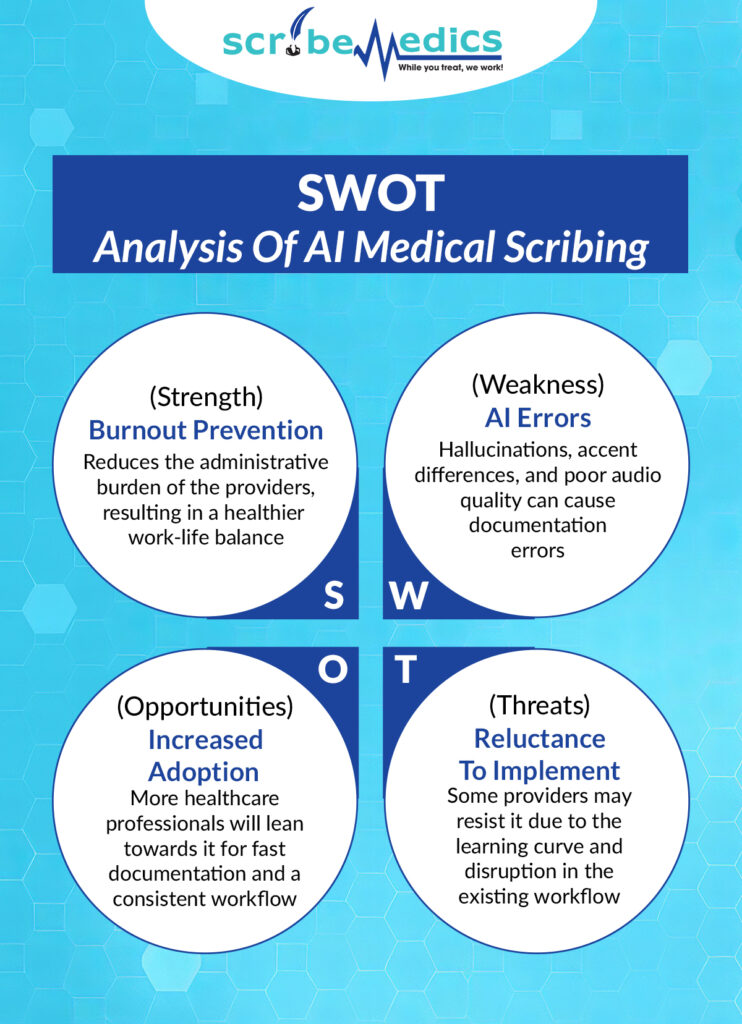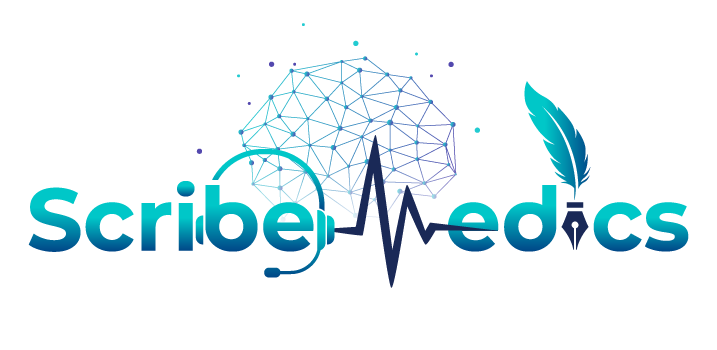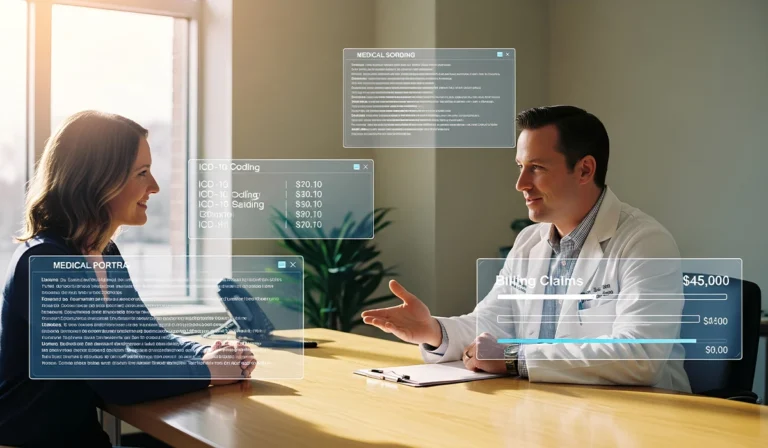With the growing demands of clinical documentation, medical scribing services are evolving, too. Healthcare providers are looking for effective ways to reduce their administrative workload. What was once a role focused solely on transcribing doctor-patient conversations is now becoming more dynamic with each passing day. This field is revolutionizing with innovative steps like AI medical scribes in healthcare.
Modern scribes are not only handling the paperwork but also using new technologies to streamline the process. Besides saving the clinicians’ time, artificial intelligence can help to accelerate the work process and allow physicians to have a healthy work-life balance. In this blog, we explore the key trends shaping the future of medical scribing and how it can align with the changing healthcare environment.
What Are AI Medical Scribes In Healthcare?
AI medical scribes are digital assistants powered by artificial intelligence to help doctors and other healthcare providers with documentation. This is one of the key administrative tasks that drains most of the time of the physicians. AI scribes can listen to the patient-doctor conversation and provide real-time documentation. Hence, the physicians do not have to think about quickly wrapping up the consultation so that they can sit with charting.
Scribe AI is responsible for entering important details directly into the EHRs, streamlining the care delivery process. They also ensure no clinical data is missed and that the care plan follows the correct direction. As the AI medical scribe services free up more time for doctors, they can focus solely on patient outcomes. With less paperwork, the number of burned-out healthcare professionals decreases, improving the overall efficiency of the health industry.
Benefits Of AI Medical Scribe
In the United States of America, the healthcare landscape is complicated due to the rising number of burned-out professionals. AI scribe for doctors can benefit the health sector in many ways. The major advantages are mentioned below:

1. Saves Time
The use of AI medical scribesin healthcare can free up a lot of time for the providers, allowing them to focus on their overall well-being. The doctors can use this time for self-care or self-development. They can maintain a healthy work-life balance to boost productivity. Also, they can take up more consultations, thereby enhancing access to care. ScribeMedic’s virtual medical scribe services can save you time so that you can concentrate more on the patients.
2. Prevents Burnout
Burned-out professionals cannot contribute much to easing the healthcare burden. AI medical scribes in healthcare are essential for focusing on completing administrative tasks to reduce screen time for doctors. It also saves them from after-hours work, thereby reducing the instances of overworking. All of these help in preventing clinician burnout and foster a highly effective care environment.
3. High Patient Experience
As an AI medical scribe keeps burnout at bay, the physicians become highly productive at work. Therefore, the quality of care delivery improves. With the freed-up time, the clinicians can attend to more patients, thereby reducing the waiting lines and instances of delayed care in the USA. All these collectively make a positive impact on patient experience.
4. Accurate Documentation
Human errors can affect the documentation process. AI scribes aim to minimize errors and uplift the quality of documentation. As the electronic health records are properly updated, the care delivery is streamlined. It helps to keep coding or billing issues caused by human errors and enables physicians to improve patient outcomes.
5. Efficient Revenue Cycle
With error-free documentation, the medical coding and billing process is also streamlined. Lower misinterpretation or data ambiguity boosts the accuracy of documentation. Hence, the bills are correct, thereby minimizing claim denials and late payments. This helps to streamline the revenue cycle, too. Thus, the organizations overcome the challenges of lost revenue.
6. Cost Savings
Unlike virtual scribes, AI-powered medical scribing services do not require monthly salaries or payments. Also, traditional transcriptionists require a full office setup, which calls for additional expenses. An AI medical scribe requires a one-time investment instead, saving the physicians from a fixed monthly cost. Also, there is no requirement for office setup-related costs, allowing them to save their hard-earned money.
7. Scalability and Accessibility
While human scribes can work during limited hours, AI medical scribes in healthcare can provide 24/7 service. This helps to improve the efficiency of healthcare professionals. Therefore, they can focus more diligently on care provision. AI medical transcription is highly scalable due to zero hiring or logistical challenges. Hence, the smaller practices can adopt it quickly and align it to their operations.
8. Improved Compliance
AI medical scribes in healthcare provide timely patient records, streamlining the audits. This information is also necessary to safeguard clinicians from legal complexities. There are some AI medical scribing solutions that provide a clear trail of the note-generation process to support auditing. These systems are necessary to minimize risks, as critical information like medication allergies is captured consistently.
Challenges Of AI Medical Scribes In Healthcare
Despite all the above-discussed advantages, AI scribe medical services can face multiple challenges. It is important to learn about them to understand the relevant problems that may come with them.
1. Accuracy and Reliability Errors
Speech recognition errors are common in AI medical scribing. Different accents, dialects, complex medical terms, low-quality audio, fast and overlapping conversations, etc., are key contributing factors. Poor contextual understanding and hallucinations can also pose integral challenges to documentation accuracy. Meanwhile, complicated discussions may result in incomplete updation of EHRs as the AI scribes may end up missing key clinical data.
2. Poor Clinical Oversight
Even if the artificial intelligence conducts the administrative tasks in less time, it requires thorough checking and editing before being considered the final version. This editing process may take a lot of time, thereby further burdening the doctors with non-medical tasks. Also, documentation errors can pose legal risks for the physician as it will be signed under their name, regardless of whether anyone else is responsible for the mistake.
3. Workflow Integration Issues
Integration of new technology (e.g., artificial intelligence) can disrupt existing operations. Therefore, it will threaten the overall seamlessness of the process. Updating electronic health record systems can be complicated. It will vary based on the vendors in the USA. Also, there are some systems that cause alert fatigue, resulting in challenges.
4. Low Privacy and Compliance
The American health industry deals with highly sensitive patient health information (PHI). Poor HIPAA compliance or a lack of robust systems can collectively have an impact on patient privacy. If the vendor does not offer data protection, it can land the physician in legal trouble. Also, there are challenges associated with data ownership and utilization. Informed consent is necessary, as not everyone is aware of technological advancements like an AI medical scribe. Additionally, it is essential to check whether the documentation process is aligned with the billing standards. ScribeMedics provides you with HIPAA-compliant scribing solutions.
5. Cost and Value Proposition
As it is known, AI medical transcription comes with high implementation costs. From hardware upgrades to monthly subscription fees, the charges can reach sky-high if there is no proper planning. Also, it is difficult to forecast ROI and calculate the expenses upfront. The ROI uncertainty and additional costs can pose a burden on clinicians in the United States of America, leaving them struggling with finances.
6. Clinician Adoption and Trust
Resistance to new technological advancements can create challenges for physicians. This reluctance is mostly due to the learning curve that comes along. At times, the patient rapport is affected when they learn about a system recording the conversation instead of the physician. The loss of authority over the documentation process also hinders some clinicians. As a result, they are reluctant to integrate AI scribe solutions into their regular workflow.
7. Ethical and Bias Considerations
While artificial intelligence takes pride in faster documentation, it cannot guarantee error-free outcomes. Algorithmic bias is very common for AI medical scribes in healthcare. It reduces the quality of patient records, thereby affecting the treatment process. Templated notes due to poor clinical insights are another drawback of AI scribe for therapists. All these make a collective impact on clinical reasoning in the long run.
8. Technical Limitations
Background noise can disrupt the audio, keeping the AI scribe from listening properly to the conversation. This will lead to increased documentation errors. If there are multiple speakers, there are more disruptions. Also, heavy reliance on the internet connection is another key challenge. An unstable broadband connection may lead to inefficient documentation, thereby affecting the overall treatment plan.
Rise Of AI-Human Collaboration
AI medical scribes in healthcare now handle routine transcription and data entry with impressive speed, and some systems maximize accuracy and reduce documentation time to a greater extent. However, AI is prone to misjudge clinical context or invent unlikely exam details. Background noise or poor understanding of accents can keep them from achieving higher levels of documentation accuracy.
When one integrates artificial intelligence into human scribe solutions, the EHR updation reaches an optimal level of accuracy. AI prepares draft notes, then human scribes step in to correct errors. They play a key role in interpreting nonverbal cues, simplifying complex phrasing, and ensuring legal and ethical compliance. This partnership enhances accuracy, saves clinicians valuable time, and enhances coding and billing precision.
Beyond supporting clinicians, hybrid scribing teams adapt to specialty-specific workflows, multilingual needs, and varying clinical depths. They also help train physicians and scribes alike to interact with and refine AI outputs, creating a virtuous cycle of learning and quality enhancement. In other words, the future of medical documentation isn’t an AI takeover. While the systems deliver speed and consistency, human oversight brings empathy and context. It is a human-AI symphony. Therefore, these two key factors are working together to improve the quality of patient records and reduce the number of total burned-out healthcare professionals in the USA.
Knowledge and Training Requirements For Modern Scribes
As AI medical scribing is slowly taking over the health industry, it has become essential for modern scribes to upskill themselves for higher-quality patient outcomes. Let us check various knowledge and training requirements in this context that will be helpful.
1. AI Literacy
They must have a basic understanding of the relevant technologies associated with AI medical scribes in healthcare. Knowledge about speech recognition, natural language processing NLP, and large language models is integral in this context. The human scribes must be aware of the advantages and limitations of AI so that they can steer them accordingly for the optimal results. A brief understanding of data security and workflow can contribute to accurate medical records.
2. Advanced Editing
This is directly linked to quality assurance. The human scribes must be provided with training to accurately review and revise the draft notes created by AI medical scribes. This will not only help to reduce editing time but also enable them to ensure the overall quality of the clinical notes. Advanced editing skills help with the identification of AI errors, wrong context insertion, and hallucinations. If necessary, the individual must add or eliminate irrelevant data to ensure higher levels of accuracy.
3. Enhanced Communication
Feedback skill is of utmost importance. The human scribes must learn how to efficiently provide feedback to both the physician and the AI scribe. While the clinicians must understand the importance of clear dictation free from distractions, the AI system should learn about potential errors. It is essential for them to understand when they should flag the errors that will save the providers from legal complexities. Also, the development of clear communication protocols can improve the outcomes.
4. Workflow Optimization
AI workflow is a complex process, and human scribes must have a thorough understanding of it. Learning about the steps allows the scribes to determine how to review the draft clinical notes efficiently. They must ensure that the providers know about the best practices to keep audio disruptions at bay, e.g, background noise. Training on troubleshooting common issues can maximize the effectiveness of AI scribes for doctors.
How Does ScribeMedics’ Hybrid AI Medical Scribe Overcome These Challenges?
With the overwhelming burden of administrative tasks, healthcare professionals have become more prone to burnout. This is affecting their productivity, thereby creating challenges for efficient care delivery. Artificial intelligence is aiming for better results. The growing inclination towards AI medical scribes in healthcare is slowly changing the care delivery landscape for good.
However, AI is prone to errors caused by algorithmic bias, hallucinations, audio disruption, etc. Inaccurate documentation leads to wrong billing, thereby affecting the seamlessness of the process. Also, it greatly affects the patient’s recovery. ScribeMedics, one of the top online medical scribe service providers in the USA, can boost documentation accuracy while speeding up the entire process.
As fast and accurate documentation is the key objective, a collaboration of AI and human scribes can maximize the outcomes. ScribeMedics’ hybrid AI medical scribe model focuses on reduced administrative burden through AI speed and human oversight. As the artificial intelligence will speed up the documentation, human scribes will identify errors to ensure the overall accuracy of the EHRs.
This hybrid model can improve the workflow and enable physicians to maintain a healthy work-life balance. If you are a healthcare professional looking for a scribing solution to reduce your administrative burden, contact us!
Conclusion
The human-AI collaboration is one of the key trends to look for to reduce the administrative burden in the health industry. As the number of burned-out professionals increases, it leads to operational inefficiency and delayed care. With the collective use of AI and human scribes, it is possible to close the gaps and foster superior quality of care for the patients.
AI medical scribes in healthcare are revolutionizing the medical workflow. Documentation accuracy leads to short recovery phases, lower claim denials, and lower clinician burnout. As human oversight ensures that AI errors are removed, it improves the documentation quality, thereby streamlining the workflow. Therefore, the rise of human-AI collaboration is expected to benefit not only the providers but also the patients. However, it is important to ensure that the humans involved in the process are trained accordingly.
Frequently Asked Questions
AI Medical scribe technology is a tool that allows physicians to spend less time on administrative tasks. Artificial intelligence listens to the provider-patient encounter and transcribes it to error-free clinical data. It leverages technological advancements to ensure enhanced efficiency. AI scribes allow physicians to spend less time looking at the screen and keep burnout at bay.
While the tool handles much of the note-taking, a human scribe or medical professional often reviews the final version to make sure everything is accurate. It is especially useful in busy clinics, where saving time and reducing stress are important. That said, patient privacy and secure handling of medical information remain a top priority whenever this kind of technology is used. ScribeMedics’ hybrid AI scribe model brings you AI speed and human oversight.
As a medical scribe works closely with the patients and providers, they learn about various methods to improve their overall practices. The opportunity helps them understand how clinical settings operate. It is often a stepping stone for those planning a career in the healthcare sector. They learn about the patient inflow, type of challenges, etc. As time passes, they become experienced and are responsible for guiding the newly joined medical scribes.
While it is known that medical scribes are not directly associated with patient care, it is they who steer the care plan in the right direction by updating the EHRs with accurate details. However, incorporating AI with human oversight can bring extraordinary outcomes. ScribeMedics’ hybrid AI medical scribe can speed up the documentation while producing an error-free result.
Artificial intelligence (AI) is changing the way the healthcare sector has been operating till now. It is streamlining the non-medical tasks to ensure that the providers can focus more on care delivery. AI medical scribe services are completing bulk documentation in a shorter time. Also, Scribe AI is updating electronic health records in real time, improving documentation accuracy. Enabling physicians to balance their personal and professional lives by reducing their screen time for administrative tasks.
AI medical scribes in healthcare are allowing doctors to take up more consultations. Therefore, the waiting time is decreasing, and patient satisfaction is going up. ScribeMedics’ hybrid AI Scribe model is a more advanced formula where human oversight is used to eliminate AI errors, thereby improving the quality of care.
The best AI medical scribe tools listen in on doctor-patient conversations, transcribe them in real time, recognize clinical language, filter out irrelevant small talk, and generate structured notes. Seeking consent from the patient is a mandatory practice. These notes are automatically formatted for electronic health records, complete with summaries, coding, billing details, and even follow-up prompts. Reportedly, these tools can save almost an hour’s worth of paperwork daily. Thus, doctors can engage with patients properly and reduce burnout.
The technology integrates NLP, voice recognition, and EHRs, and increasingly offers real‑time clinical suggestions. Despite occasional transcription errors or “hallucinations,” clinicians review and refine outputs, ensuring accuracy. Overall, AI scribes streamline documentation and improve patient interaction without replacing the doctor.
Artificial Intelligence (AI) is transforming medical scribing. AI scribes use speech recognition and natural language processing NLP to automate transcription, real-time documentation, and patient summaries directly into EHRs. Clinicians are saving massive documentation time, reducing burnout, and redirecting focus toward patient care. Despite occasional errors and data privacy concerns, human review remains essential.
Emerging systems also offer specialty tuning, multilingual support, predictive prompts, and smoother EHR integration. Errors are the result of hallucinations, disruptions, etc. In effect, AI is reshaping scribing into a hybrid model where machines draft efficiently, and humans refine for nuance, quality, and empathy. ScribeMedics’ hybrid AI medical scribe model can revolutionize the way electronic health records EHRs are updated.
Scribe AI documentation services are quickly evolving. Which started with the transcription of doctor-patient conversations, is now going on with drafting visit summaries, updating electronic health records, and even assisting with billing. Going forward, they’ll integrate deeper, reviewing past records before visits, offering real-time care suggestions, connecting with wearables and telemedicine systems, and supporting multiple languages for global use.
While accuracy improves with advanced NLP and specialty-focused learning, human review remains essential to correct errors and preserve empathy. The future clearly lies in hybrid scribe teams: AI captures the bulk, and trained professionals add clinical nuance and oversight. This balance is reshaping documentation, making it faster, more accurate, and more human-centered while keeping clinicians focused on patient care.
Artificial Intelligence (AI) is changing the way healthcare is operating today. Integration of AI in the scribing solutions has brought enormous scope to streamline medical billing and coding, thereby improving the quality of care delivery. Artificial intelligence reduces documentation time. Therefore, physicians using AI-powered scribing systems can carry out bulk administrative tasks in less time.
By reducing the documentation time, AI medical scribes in healthcare shorten the recovery phase. This also helps to improve the effectiveness of health operations. ScribeMedics’ hybrid AI medical scribe model uses artificial intelligence to speed up administrative tasks and enhance the overall efficiency of healthcare professionals.
The increasing adoption of AI medical scribes in healthcare has raised questions associated with compliance. Reputed organizations ensure their services are aligned with all the relevant standards and guidelines, including HIPAA. However, full compliance requires that the healthcare organization ensure the vendor is focused on informed consent, follows regulatory practices, and has a legal flow of operations.
To sum up, AI scribes can be HIPAA compliant only if they are properly contracted, consented to, and implemented under the current privacy policies. It is important to run a background check or look for testimonials if you are outsourcing AI scribing solutions. ScribeMedics can provide you with HIPAA-compliant AI medical transcription services to boost your work productivity.
AI and humans working together transform clinical documentation. Artificial intelligence promptly transcribes consultations, organizes data, and integrates with electronic health records. All of these in a shorter time span. In the meantime, human scribes refine notes, identify errors, interpret context, eliminate data ambiguity, and preserve empathy. This blend boosts accuracy and speed, reducing physician paperwork, easing burnout, and increasing face-to-face time with patients.
Also, it enhances coding precision and revenue, supports complex specialties, and maintains high-quality, human-centered documentation. To sum up, this human-AI combination delivers efficient, reliable records without sacrificing the personalized care and oversight only humans can provide.
AI has revolutionized scribing by transcribing in real time. It drafts comprehensive clinical notes and integrates data. Above all, it relieves doctors from the overwhelming administrative burden. However, it is far from perfect. AI misinterprets jargon, accents, and nuanced context, thereby resulting in documentation gaps. These can downgrade the quality of patient records, affecting care delivery. Doctors still need to review and polish notes for accuracy, empathy, and compliance.
As the industry is shifting towards AI-human collective scribing efforts, it has become more important to follow relevant guidelines. AI handles bulk transcription, and humans refine the output, bridging speed with precision. While some roles handling repetitive tasks may diminish, the care delivery-related jobs will continue to thrive. Lastly, it can be concluded that AI scribes will augment, not replace, human scribes.
Dinesh Kumar is a healthcare workflow architect and clinical documentation expert with over a decade of real-world experience supporting physicians across multiple specialties in the United States. As the Co-Founder of ScribeMedics, he has helped transform how medical practices handle documentation, coding, and administrative workflows, reducing burnout, improving patient flow, and enabling clinicians to reclaim their day.
Since 2013, Dinesh has worked closely with providers on the front lines of patient care. Over the years, he witnessed a recurring problem: clinicians were drowning in administrative work, spending hours after clinic hours updating charts, reconciling notes, and managing documentation backlogs. Instead of accepting this as “part of the system,” he decided to fix it.
Under his leadership, ScribeMedics has grown into a global hybrid scribing and documentation support company known for accuracy, compliance, and reliable workflows. From medical scribes and CPC-certified coders to virtual back-office support, his teams help multispecialty practices increase revenue integrity, reduce charting time, and improve patient-physician satisfaction.
Dinesh works with healthcare providers, practice owners, and attorneys who want streamlined documentation, better reimbursement outcomes, and more efficient operations. His approach blends empathy, process engineering, and deep domain expertise to create systems that work, day after day.
When he isn’t optimizing clinical workflows, Dinesh mentors documentation teams, trains young professionals, and speaks about burnout prevention, workflow design, and the future of hybrid AI-driven scribing.









 Medical Transcription
Medical Transcription Medical Billing
Medical Billing Medical Coding
Medical Coding